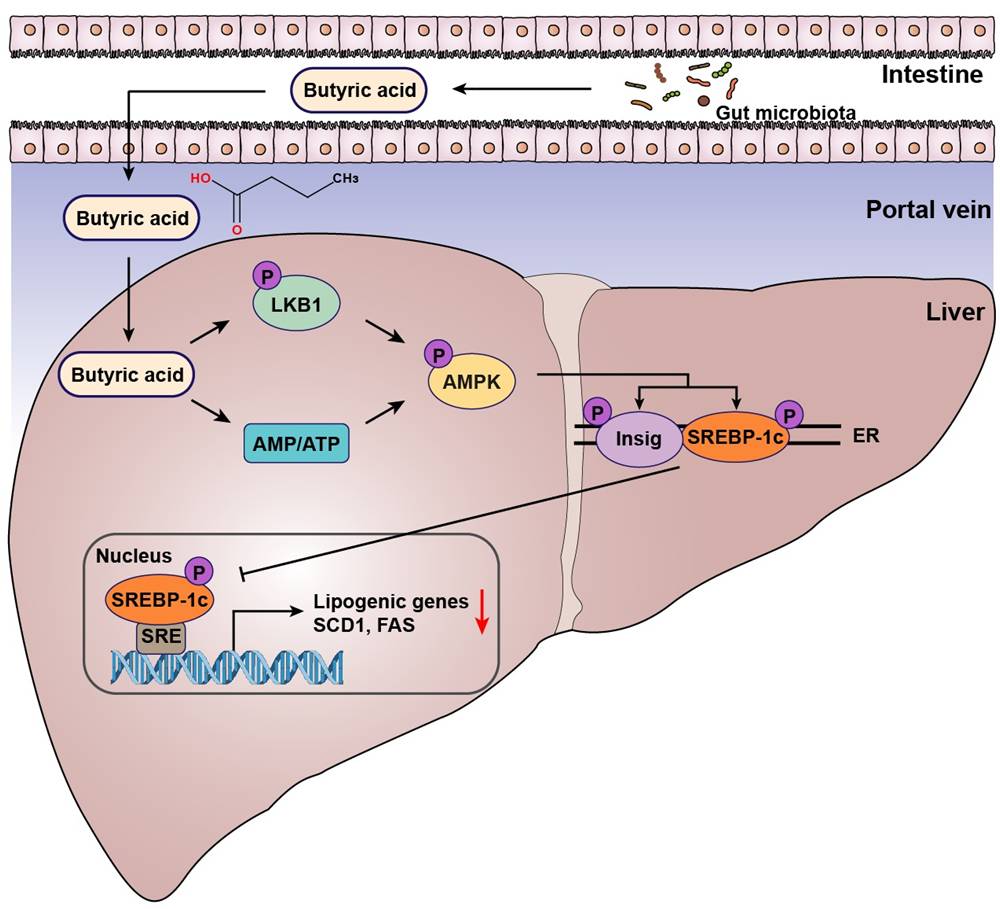Gut Microbial Metabolite Sodium Butyrate Attenuates Hepatic Steatosis
Hepatic steatosis is a characteristic pathologic alteration in nonalcoholic fatty liver disease (NAFLD) and disrupted lipid metabolism represented by irritated de novo lipogenesis is a vital pathophysiologic mechanism of hepatic steatosis. Butyric acid is a species of short-chain fatty acid which is produced by gut microbiota. Current evidence has shown that butyric acid plays an important role in metabolic regulation. It can exert systemic effects on the regulation of glucose and lipid metabolism by stimulating the production of gut hormones such as glucagon-like peptide 1 (GLP-1). However, whether and how butyric acid participates in the hepatic metabolic regulation remains to be clarified.
In collaboration with Dr. FAN Jiangao at Xinhua Hospital Affiliated to Shanghai Jiaotong University School of Medicine, a team of scientists led by Professor LI Yu from Shanghai Institute of Nutrition and Health of the Chinese Academy of Sciences demonstrated that exogenous supplementation of gut microbial metabolite sodium butyrate activates liver kinase B1 (LKB1) and enhances protein level of insulin-induced gene (Insig), thereby inhibiting hepatic lipogenesis. These findings reveal a novel mechanism by which gut-derived short-chain fatty acids protect against hepatic steatosis.
In this study, scientists induced a mouse model of NAFLD by high-fat diet feeding and administration of sodium butyrate was given by gavage for 8 weeks. The results showed that the hepatic steatosis and serum parameters reflecting liver injury were both improved.
Moreover, in vivo and in vitro approaches demonstrated that sodium butyrate directly targets hepatocytes, enhances phosphorylation of LKB1 and elevates the intracellular AMP/ATP ratio, thereby facilitating AMPK activation. Meanwhile, sodium butyrate enhances the interaction between AMPK and Insig and increases the protein level of Insig, which leads to reduced cleavage and transcriptional activity of SREBP-1c, decreased hepatic de novo lipogenesis and attenuated steatosis in the liver.
The study revealed that pharmacological administration of sodium butyrate improves hepatic steatosis in high-fat diet-fed mice. The stimulatory effects of sodium butyrate on Insig-1 activity are dependent on AMPK. LKB1 is required for the activation of AMPK in response to sodium butyrate treatment. Sodium butyrate inhibits hepatic lipogenesis via LKB1-AMPK-Insig signaling pathway. These studies also highlight that therapeutic approaches, such as LKB1 and Insig activators in hepatocytes, may have potential for the treatment of NAFLD.
This work was published online in Cellular and Molecular Gastroenterology and Hepatology on May 10, 2021 as a research article entitled “Sodium butyrate supplementation inhibits hepatic steatosis by stimulating liver kinase B1 and insulin-induced gene”. This study was funded by the grant from National Key R&D Program of China, National Natural Science Foundation of China, Key Laboratory of Wuliangye-flavor Liquor Solid-state Fermentation of China National Light Industry, Shanghai Science and Technology Commission.

The proposed model for butyric acid-mediated inhibition of lipogenesis via LKB1-AMPK-Insig signaling pathway. (Image provided by Dr. LI Yu’s laboratory)
Media Contact:
WANG Jin (Ms.)
Shanghai Institute of Nutrition and Health,
Chinese Academy of Sciences
Email: sibssc@sibs.ac.cn
Web: http://english.sinh.cas.cn/
